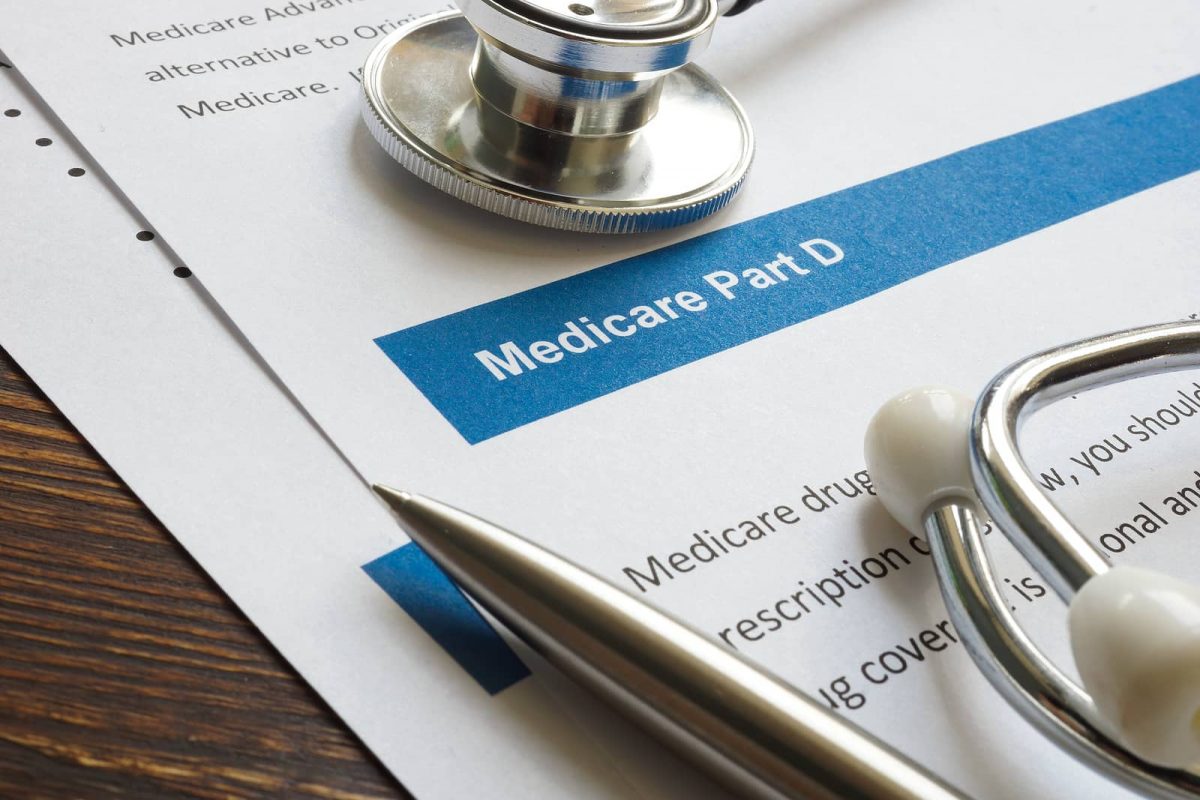
It’s the Annual Enrollment Period again, so it’s time to review your 2023 Medicare Part D drug plan. We’ll review changes that affect all Medicare beneficiaries, including the 2023 coverage phases, the new insulin cap, and what to look for when choosing a new plan.
2023 Medicare Part D Drug Plan Availability
Each year Medicare Part D plans to update its formularies, costs, and coverages. Some beneficiaries elect to stay on their current plan after they review their Annual Notice of Change (ANOC). In contrast, others look to find coverage more suitable to their needs. Part D prescription drug plans have increased by 5% to 801 for 2023.
2023 Medicare Part D Drug Plan Coverage Phases and Costs
The Centers for Medicare & Medicaid Services set the standard Part D model and remain the same, except for increased Medicare costs to reach each coverage phase. The average 2023 Medicare Part D Drug plan premium has risen to $31.50.
The Part D deductible phase is $505. Once you’ve met the Part D deductible, you move from the deductible phase to the initial coverage phase. In the initial coverage phase, you’ll pay the plan copay or coinsurance outlined until the retail drug costs reach $4,660. Once your retail drug costs reach this amount, you’ll move to the coverage gap phase.
To complete the coverage gap phase this year, you’ll need to reach $7,400 of out-of-pocket costs toward your drug coverage. Once this is complete, you’ll move to the final stage, the catastrophic coverage phase. In this final phase, you’ll pay the greater of 5% or a small copay for your drug costs for the remainder of the year.
Capping Insulin Costs in 2023
The Inflation Reduction Act did have a section modifying how Medicare Part D drug plans work. Some aspects of the IRA will take effect in 2023. Cost-sharing on covered insulins will be capped at $35. This change will help lower costs for many Medicare beneficiaries who must choose between putting food on their table or taking their recommended insulin dosages.
Recommended Vaccines Covered at 100%
Beginning on January 1, 2023, recommended vaccinations or immunizations will no longer be a cost. This change will include the shingles vaccine, which used to be covered as a tier 3. It will be a welcome change for beneficiaries paying quite a penny for specifically recommended vaccines.
Several other changes regarding the Inflation Reduction Act will be rolled out over the next few years.
Annual Notice of Change
Your plan must send your ANOC out before the Annual Enrollment Period, and the ANOC will outline the changes that will occur in your current program. These changes can include pricing, changes to your covered drugs on the formulary, new tier determinations, and more. Of course, in most cases, you can remain on your current plan if the changes are acceptable. Still, you could miss out on more comprehensive coverage.
Remember, every plan is making changes, so there may be other options that will cover your prescription medications better.
Things to Consider When Reviewing 2023 Medicare Part D Prescription Drug Plans
It’s wise to look at what’s available and review your situation each year. Below we’ll provide a checklist to help with your decision-making process.
- What plans cover my prescriptions the best?
- Since each plan is different, you should check your drugs vs. the plan formularies to determine which will provide you with lower costs.
- Is my pharmacy covered?
- Not all plans cover the same network pharmacies. Make sure your preferred pharmacy is covered in the programs you select.
- Mail Order can also provide lower costs for your prescription medications.
- Keep in mind that pharmacies have different negotiated rates, so it may be worth changing the pharmacy to lower costs.
Selecting the proper drug plans can be time-consuming, but using a licensed insurance agent can help speed up the process. They have tools and access to enter your prescriptions and pharmacy to see which plans cover them adequately.
Tools Plans Can Use to Lower Costs
Companies that offer Medicare Part D coverage options can use a few tools to help keep prescription drug costs down for their enrollees. Tools such as prior authorization, step therapy, and quantity limits help keep costs down. They ensure that doctors aren’t just prescribing a more expensive brand-name drug when generic drugs will suffice.
Prior Authorization requires your healthcare provider to send a request explaining why the drug is necessary before the plan covers it.
Step Therapy requires the healthcare provider to try a less expensive prescription before a more expensive drug is covered.
Quantity Limits put a cap on how much of a specific drug you can receive between refills.
Drugs affected by these tools can be found in the health plan information.
How Much is Medicare Part D Penalty
For each month you’re eligible for a Medicare PDP and don’t enroll, you could be accessed a 1% penalty. This penalty remains as long as you’re enrolled in a program. This Medicare Part D penalty isn’t applied if you’re enrolled in creditable coverage such as an employer group plan.
The penalty compounds 1% each month and uses the average monthly premium of Medicare Part D plans to calculate how much you’ll pay. Let’s assume you went ten months without drug coverage. Your penalty would be 10% of $31.50. This penalty would work out to $3.15
Ways to Battle High Drug Costs
A few programs can help cover the costs of your prescription drugs or even plan premiums. The Low-income Subsidy program (LIS) or Extra Help is a federal plan based on income. This program can help lower or remove costs associated with deductibles, copays, coinsurance, premiums, and even the Part D penalty.
You can also check with your State Pharmaceutical Assistance Program (SPAP) for additional assistance.
FAQs
What is the Medicare Part D deductible for 2023?
The Medicare Part D deductible has increased to $505 for 2023. This is a $25 increase from the previous year
What will be the IRMAA for 2023?
The Part D IRMAA is dictated by the adjusted gross income of the previous tax returns. It will vary depending on the individual.
The Income Related Monthly Adjustment Amount is based on your income from two years prior.| Beneficiaries who file individual tax returns with modified adjusted gross income: | Beneficiaries who file joint tax returns with modified adjusted gross income: | Income-related monthly adjustment amount for 2023 |
|---|---|---|
| Less than or equal to $97,000 | Less than or equal to $194,000 | $0.00 |
| Greater than $97,000 and less than or equal to $123,000 | Greater than $194,000 and less than or equal to $246,000 | $12.20 + Plan Premium |
| Greater than $123,000 and less than or equal to $153,000 | Greater than $246,000 and less than or equal to $306,000 | $31.50 + Plan Premium |
| Greater than $183,000 and less than $500,000 | Greater than $366,000 and less than $750,000 | $70 + Plan Premium |
| $114,000 to $1Greater than or equal to $500,000 | Greater than or equal to $750,000 | $76.40 + Plan Premium |
What drugs does Medicare Part D not cover?
Medicare Part D is required to cover at least one drug from each Medical category. The exceptions are drugs for cosmetic purposes and medicines not approved by the FDA. The following categories won’t be covered under Medicare Part D.
- drugs for hair growth
- fertility drugs
- medications covered by Medicare parts A and B
- medications for erectile dysfunction
- over-the-counter drugs
- Minerals and Vitamins
- weight management medications
Will Medicare premiums decrease in 2023?
Yes! The Medicare Part B premium, which most Medicare beneficiaries will pay, will be adjusted to $164.90.
What are the maximum out-of-pocket drug costs for 2023?
There isn’t currently a maximum out-of-pocket for Medicare Part D drug costs. Part of the Inflation reduction act will add a maximum out-of-pocket limit of $2000 beginning in 2025.
What is the maximum amount a person can spend out of pocket for 2023?
Unfortunately, suppose you have Original Medicare only and Medicare Part D prescription drug coverage. In that case, there isn’t a limit on what you can spend. You can, however, add a Medicare Supplement plan or a Medicare Advantage plan to limit your Medical expenses.
For drug coverage, there isn’t a limit on how much you can spend. There will be a drug limit starting in 2025.
How much are the premiums for Medicare Part D?
Medicare Part D premiums for 2023 will vary greatly depending on where you live and the chosen plan and insurance company. The average monthly premium for Medicare Part D coverage is $31.50.
Getting Help Determining the Right 2023 Medicare Part D Plan For You
We can help! Our licensed insurance agents are specialists in all aspects of Medicare. Let us help guide you and provide solutions for all your Medicare Needs.
Fill out our online request form, or give us a call. We’re here to help make Medicare simple!
The post 2023 Medicare Part D Drug Plans: What You Need to Know appeared first on Medigap.com.
from Medigap.com https://www.medigap.com/faqs/2023-medicare-part-d-drug-plans/
via IFTTT

No comments:
Post a Comment